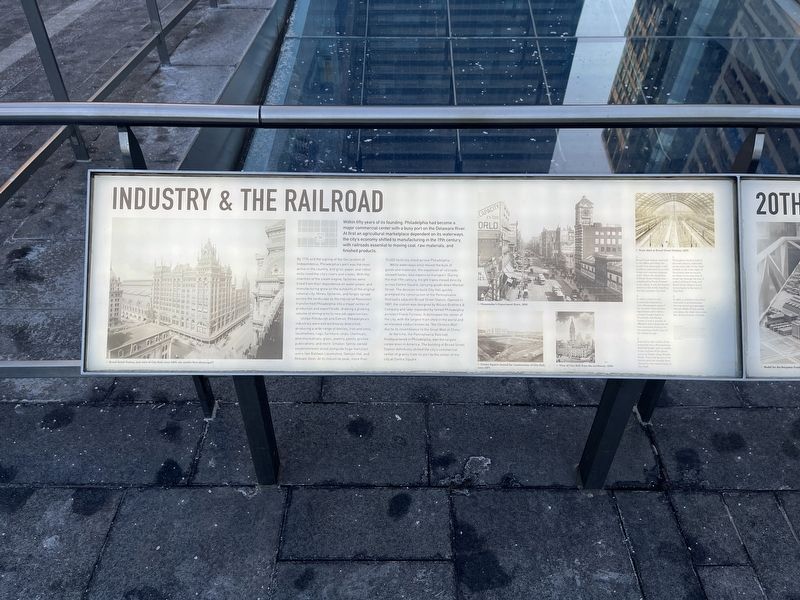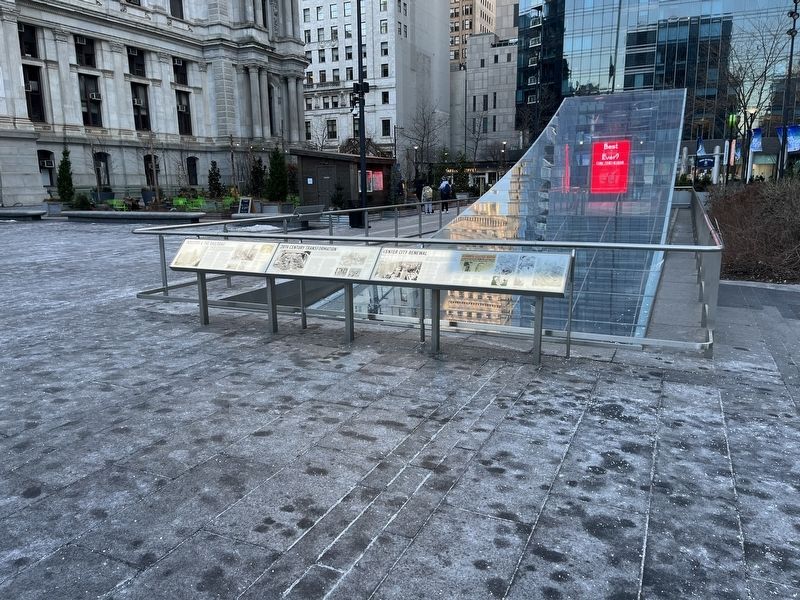William Penn Annex West in Philadelphia in Philadelphia County, Pennsylvania — The American Northeast (Mid-Atlantic)
Industry & the Railroad
Within fifty years of its founding, Philadelphia had become a major commercial center with a busy port on the Delaware River. At first an agricultural marketplace dependent on its waterways, the city's economy shifted to manufacturing in the 19th century, with railroads essential to moving coal, raw materials, and finished products.
By 1776 and the signing of the Declaration of Independence, Philadelphia's port was the most active in the country, and grist, paper, and cotton mills lined the city's rivers and creeks. With the invention of the steam engine, factories were freed from their dependence on water power, and manufacturing grew on the outskirts on the original colonial city. Mines, factories, and forges spread across the landscapes as the Industrial Revolution transformed Philadelphia into a major center of production and export trade, drawing a growing volume of immigrants to new job opportunities.
Unlike Pittsburgh and Detroit, Philadelphia's industries were extraordinarily diversified, producing a wide range of textiles, iron and steel, locomotives, rugs, furniture, ships, chemicals, pharmaceuticals, glass, jewelry, paints, printed publications, and more. Smaller, family-owned establishments stood alongside huge manufacturers like Baldwin Locomotive, Stetson Hat, and Midvale Steel. At its industrial peak, more than 15,000 factories stood across Philadelphia.
While waterways once moved the bulk of goods and materials, the expansion of railroads allowed faster, less expensive transport. During the mid-19th century, freight trains moved directly across Centre Square, carrying goods down Market Street. The decision to build City Hall quickly prompted the construction of the Pennsylvania Railroad's adjacent Broad Street Station. Opened in 1881, the station was designed by Wilson Brothers & Company and later expanded by famed Philadelphia architect Frank Furness. It dominated the center of the city, with the largest train shed in the world and an elevated viaduct known as "the Chinese Wall" due to its resemblance to the Great Wall of China.
At the time, the Pennsylvania Railroad, headquartered in Philadelphia, was the largest corporation in America. The building of Broad Street Station definitively shifted the city's commercial center of the City at Centre Square.
[Captions:]
Broad Street was built in the 1880s and likely the world's first skyscraper, a tall building supported by an iron frame with exterior masonry walls. When the expansion of Broad Street Station was completely bu Frank Furness in the 1890s, it was the largest station in the world, standing directly opposite City Hall.
2. In 1876, in time
3. Essential to the vitality of the industrial city, a Pennsylvania Railroad freight train is visible at the midline of this photo, carrying freight along Market Street. Trees and fences of the former park had already been cleared for the construction of City Hall.
4. Throughout the first half of the 20th century, sidewalks on the west side of City Hall (visible in the lower right of the photo) were as narrow as those on the east side. A street ran through the site of today's Dilworth Park, and Broad Street Station stood immediately to the west of City Hall.
5. In 1892, a massive train shed was built to accommodate the ever-growing passenger volume. Made of iron, wood, and glass, the shed rose to 100 feet above 16 lanes of tracks.
Topics and series. This historical marker is listed in these topic lists: Architecture • Industry & Commerce • Railroads & Streetcars. In addition, it is included in the Pennsylvania Railroad (PRR) series list. A significant historical year for this entry is 1776.
Location. 39° 57.152′ N, 75° 9.885′ W. Marker is in Philadelphia, Pennsylvania, in Philadelphia County. It is in William Penn Annex West. Marker is at the intersection of South 15th Street (Pennsylvania Route 166) and Market Street (Pennsylvania Route 3), on the left when traveling south on South 15th Street. Touch for map. Marker is in this post office area: Philadelphia PA 19107, United States of America. Touch for directions.
Other nearby markers. At least 8 other markers are within walking distance of this marker. 20th Century Transformation (here, next to this marker); Center City Renewal (here, next to this marker); The Building of City Hall (here, next to this marker); Centre Square Water Works (a few steps from this marker); The Plan for Philadelphia (a few steps from this marker); Dilworth Park (a few steps from this marker); In Commemoration of the Men of Irish Birth or Lineage (within shouting distance of this marker); Philadelphia City Hall Gates (within shouting distance of this marker). Touch for a list and map of all markers in Philadelphia.
Credits. This page was last revised on February 2, 2023. It was originally submitted on February 9, 2022, by Devry Becker Jones of Washington, District of Columbia. This page has been viewed 100 times since then and 4 times this year. Photos: 1, 2. submitted on February 9, 2022, by Devry Becker Jones of Washington, District of Columbia.

